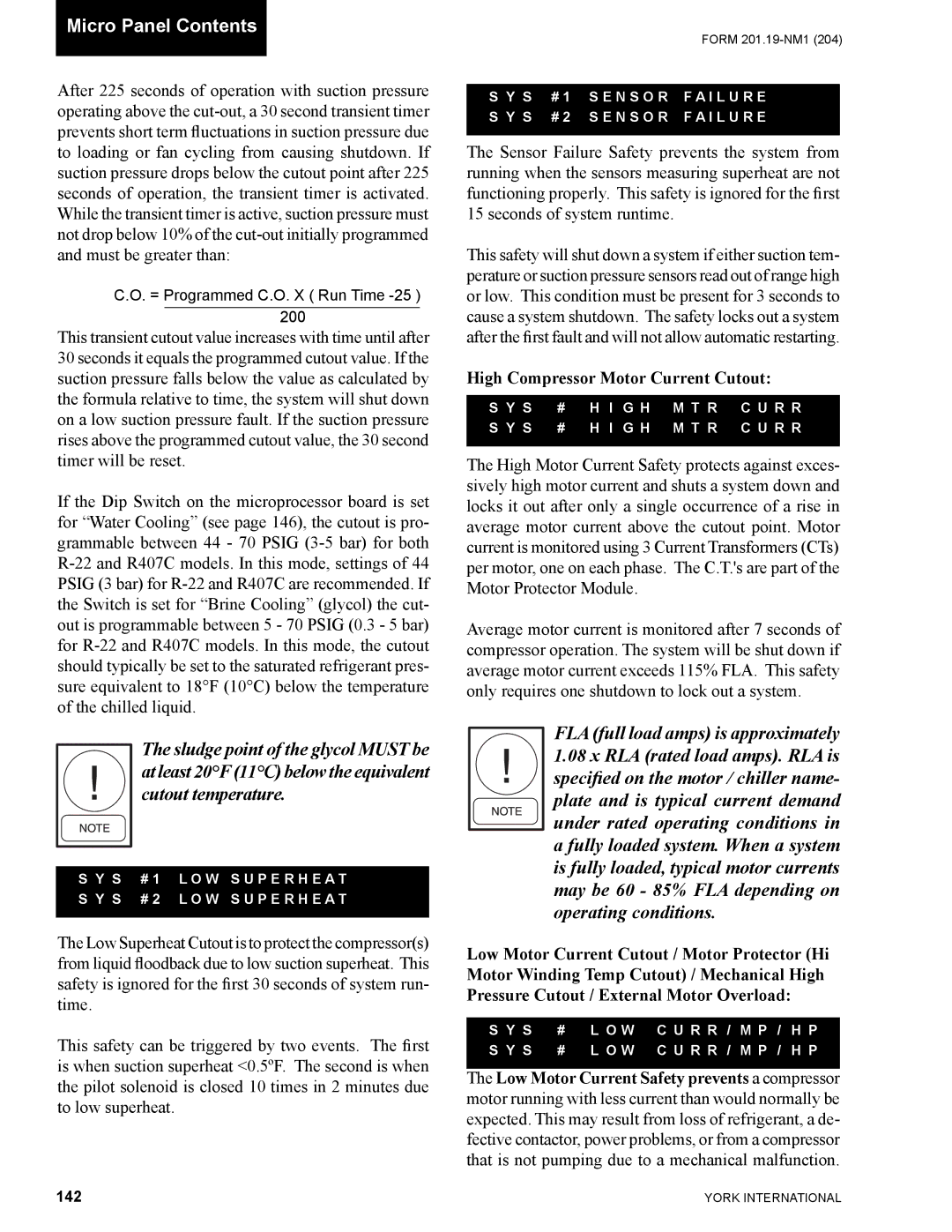
Micro Panel Contents
After 225 seconds of operation with suction pressure operating above the
C.O. = Programmed C.O. X ( Run Time
This transient cutout value increases with time until after 30 seconds it equals the programmed cutout value. If the suction pressure falls below the value as calculated by the formula relative to time, the system will shut down on a low suction pressure fault. If the suction pressure rises above the programmed cutout value, the 30 second timer will be reset.
If the Dip Switch on the microprocessor board is set for “Water Cooling” (see page 146), the cutout is pro- grammable between 44 - 70 PSIG
The sludge point of the glycol MUST be at least 20°F (11°C) below the equivalent cutout temperature.
S Y S | # 1 | L O W | S U P E R H E A T |
S Y S | # 2 | L O W | S U P E R H E A T |
|
|
|
|
The Low Superheat Cutout is to protect the compressor(s) from liquid floodback due to low suction superheat. This safety is ignored for the first 30 seconds of system run- time.
This safety can be triggered by two events. The first is when suction superheat <0.5ºF. The second is when the pilot solenoid is closed 10 times in 2 minutes due to low superheat.
|
|
| FORM | |
|
|
|
|
|
S Y S | # 1 | S E N S O R | F A I L U R E |
|
S Y S | # 2 | S E N S O R | F A I L U R E |
|
|
|
|
|
|
The Sensor Failure Safety prevents the system from running when the sensors measuring superheat are not functioning properly. This safety is ignored for the first 15 seconds of system runtime.
This safety will shut down a system if either suction tem- perature or suction pressure sensors read out of range high or low. This condition must be present for 3 seconds to cause a system shutdown. The safety locks out a system after the first fault and will not allow automatic restarting.
High Compressor Motor Current Cutout:
S Y S | # | H I G H | M T R | C U R R |
S Y S | # | H I G H | M T R | C U R R |
|
|
|
|
|
The High Motor Current Safety protects against exces- sively high motor current and shuts a system down and locks it out after only a single occurrence of a rise in average motor current above the cutout point. Motor current is monitored using 3 Current Transformers (CTs) per motor, one on each phase. The C.T.'s are part of the Motor Protector Module.
Average motor current is monitored after 7 seconds of compressor operation. The system will be shut down if average motor current exceeds 115% FLA. This safety only requires one shutdown to lock out a system.
FLA (full load amps) is approximately
1.08x RLA (rated load amps). RLA is specified on the motor / chiller name- plate and is typical current demand under rated operating conditions in a fully loaded system. When a system is fully loaded, typical motor currents may be 60 - 85% FLA depending on operating conditions.
Low Motor Current Cutout / Motor Protector (Hi Motor Winding Temp Cutout) / Mechanical High Pressure Cutout / External Motor Overload:
S Y S | # | L O W | C U R R / M P / H P |
S Y S | # | L O W | C U R R / M P / H P |
|
|
|
|
The Low Motor Current Safety prevents a compressor motor running with less current than would normally be expected. This may result from loss of refrigerant, a de- fective contactor, power problems, or from a compressor that is not pumping due to a mechanical malfunction.
142 | YORK INTERNATIONAL |
